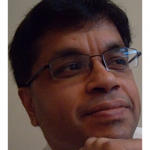Aspire to be a technology strategist, whatever your title says – the assertion by Vanguard CIO John Marcante rings true when I look ahead to what lies in store in the New Year of 2017. I have the privilege of working – and collaborating – with a distinguished set of colleagues who are technology strategists at heart and who focus across a wide spectrum of domains across the public and private sectors.
What follows is the output of a collaborative effort by this innovative bunch to put forth our collective predictions for 2017 – the year when technology has the potential to become real. I've acknowledged my colleagues who helped contribute by name at the end of this article.*
The CTO of a leading enterprise in the energy industry recently shared with me that he has put in place a Technology Realization team. The team's charter is to establish a framework that enables the continued justification of technology investments across the enterprise. This is best done by assessing the industry's use of various emerging technologies, including levels of adoption and relevance to the business of the enterprise. With that in mind, let us jump into various technological paradigms at play and explore the feasibility of 2017 being the “Year of Technology Realization!”
The following is a categorized collection of thoughts around key predictions that came out of this exercise with my colleagues:
Digital innovation hubs
Digital transformation has morphed from a trend to a central component of modern business strategy, asserts Daniel Newman, principal analyst of Futurum Research and CEO of Broadsuite Media Group.
- “Digital innovation hubs” will allow the rapid and automated development of new digital services and applications integrated to legacy systems and data.
- Traditional financial enterprises will have to initiate a digital transformation initiative driven by the consumer preference to have more control and self-service of their wealth management.
It is no longer about just “doing enterprise architecture”
- Enterprise architecture’s value proposition will shift from "doing architecture" to empowering organizations to make the best pragmatic decisions through business justifications and ROI/TCO analysis.
Acceleration of cloud adoption
- With the predominant market leaders for cloud services creating incentives and technology to help customers bridge their applications over to their platform, cloud adoption – which has stagnated in the last several months – will begin to grow and accelerate with full production applications for the mainstream customer.
- The cloud consumer will become more sensitive to being locked into vendor-specific APIs in so-called cloud-native solutions and drive the need for the ability to move easily from one provider to another.
- Federal, state, and local government agencies will accelerate their adoption of public clouds based upon the impending erosion of legacy technology skillsets and the increase in the number of FedRAMP-authorized clouds (cloud may be safe after all!).
- Pricing and risk analytic workloads will continue to be a prime candidate for cloud-bursting in the financial industry.
- Millions of 4K-capable TV devices in consumer homes will drive cloud video networks and storage exponentially. Telcos will need to build Cloud VoD and CDN service deployments at the edge of the network.
- The fight for the on-prem portion of the hybrid cloud will intensify as customers rightsize their cloud deployments. Hyperconverged solutions that are both less expensive to acquire and easier to maintain will continue to grow in popularity.
- Open APIs will become major sources of cloud monetization and will drive the volume of cloud-based application processing requirements to new levels.
Security will only get harder
- Being a secure enterprise is a competitive advantage. The chief information security officer and/or chief risk officer will take the lead in the re-assessment in historical controls choices to make new choices guided by ROI (considering cost of risk of change, cost of losing of business by *not* changing, and new value to be gained from change).
- Hello “Adversaries-R-Us!” With the increase in open libraries, larger and more wide-reaching hacks, and information stealing accelerating in the enterprise, ransomware will prompt enterprises to take creative measures to deal with the hack du jour.
- Recent events both in the political and commercial landscape will trigger a need for increased international collaboration to improve the security of information backed up with government or industry-led efforts to reduce spam, phishing, and to improve overall the security of personal email accounts. Government pressure for lawful intercept and surveillance will increase due to national security threats
- Financial institutions will align resources toward protection, detection, containment, and remediation of both external and insider threats.
- In IoT we trust – or do we? IoT devices will be used for distributed eavesdropping and theft within home/consumer networks, and will increasingly be used to launch attacks through the work devices of remote workers with home offices. In 2017, we will see new entries in the security market to combat this. Expect to see expansion of home routers to include IDS/IPS functionality, as well as increased functionality and requirement of IoT hubs to manage the security of IoT devices within the home network.
Increased exploration of Blockchain
- Blockchain has been a nebulous topic for most companies thus far. Businesses are not clear regarding how it will affect them and many exploration efforts were underway in 2016. In 2017, it’s expected Blockchain will begin to get real traction because the business problem it solves for each customer is becoming more and more obvious.
- More financial institutions will continue to experiment with Blockchain despite regulation lacking in the Blockchain space. There will be increased exploration in parallel, and thus, innovation when other industries identify potential applications – e,g, travel, telco and government.
Realize value by connecting to IoT
- Connections matter when it comes to IoT and its customers. Firms that rely on IoT will continue to push the market to begin to standardize, allowing back-end data collection and analysis to be conducted more easily and less expensively on common platforms. Remember, my favorite knowledge moment from this year's Gartner Symposium/ITxpo: Don't connect – collect!
- Traditional Informational Technology and Operational Technology markets will continue to converge as suppliers and consumers of IT and OT strive to control the evolving use cases. New use cases and business models will be discovered as the market begins to ask questions never thought of before.
- Insurers will pivot from a risk-based approach to underwriting to a model based on inputs from sensors, such as from wearable technology.
Innovative automation in real-life
- Automated commercial trucking is positioned to realize tangible business gains based upon the following factors: Trucking firms can increase productivity by redirecting the current workforce to more innovative assignments. Automated trucks can be on the road longer – maximizing the revenue from the time spent in motion.
- Outsourcing of customer service to offshore centers will start to look at robotic processes for common customer tasks in the insurance sector. This type of software will recognize language and emotions, and also will have the ability to interact with existing transactional systems and data stores.
- Insurers will be experimenting with drones for initial processing of natural disaster areas and other claim sources. This will provide a level of safety in terms of getting people to areas that have experienced disasters and also provide an initial look into the affected areas in terms of loss calculation. In that vein: Could self-driving cars speed hurricane evacuation?
Let's talk about self-healing infrastructure
What I am most fascinated by is the widening scope for collaborative Innovation – especially at the intersections. Let us first take a look at the projected growth in the individual domains listed below.
- Machine learning/AI. Enterprises will leverage machinery to process large data sets, identify patterns and generate the vital insights that will enable them to make more informed and intelligent decisions.
- Tooling landscape. IT decision makers will need tools to simplify operations, maintain end-to-end service levels, and ensure that resources adapt seamlessly to dynamic changes in workload, processing, storage, and network requirements.
- Culture of innovation. Open source will continue to be a lighter-fluid for innovation. The thriving ecosystem of open source will continue to energize the culture of engineering – DevOps – to identify fascinating intersections of technologies and perspectives.
These are three different dimensions that can potentially come together to make self-healing infrastructures real. Innovative management solutions driven by the open source community can trigger the machines to take remedial actions on themselves using the large volumes of data they are “trained” to process continuously.
OK, perhaps a little ambitious for 2017 but, technology never ceases to amaze us!
The year of the social CEO
The trend for executives to start using social media to transform firms will pick up momentum in 2017. Social engagement will get more attention, as will corporate sponsorship to augment existing channels of internal and external collaboration. The personal brand of corporate leaders will help build the corporate brand of the enterprise. Also, there is every indication that upcoming generations of political leaders are likely to use social media as a direct channel of communication with their following.
Social media will evolve from being a hobby for some into an art that differentiates the CxOs of the next generation. Say hello to a brave new (social) world of 2017!
What else?
There you have it. While all of these paradigms may not be “realized” in 2017, there is certainly promise of some seeing the light of day this year driven by market forces and consumer demand. What say you? What are your thoughts on these predictions? Are there other predictions that you have in mind?
Please let us know!
*I'd like to acknowledge my colleagues who shared their experienced insight for this article: Tarek Abdelsalam, Michael Cardy, Steven Carter, David Egts, Emery Freeman, Anthony Golia, Brent Holden, Jan Mark Holzer, Ian Hood, James Kirkland, Mike Russell, Matt Smith and Jim Tyrrell. Thank you!








